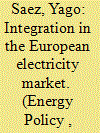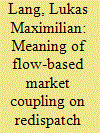| Srl | Item |
| 1 |
ID:
177332


|
|
|
|
|
| Summary/Abstract |
Within flow-based market coupling, the EU's preferred method for calculating cross-border trading capacities, recent regulatory changes stipulate minimum trading capacities, so-called minRAMs which have to be provided to electricity markets. Effectively, high predicted flows on considered electricity grid elements have to be reduced to reserve a minimum of the elements' capacities for cross-zonal trading. This analysis investigates if the adjustments made to meet this criterion, in the form of augmented trading domains, lead to higher amounts of curative congestion management. To quantify the effect of increasing minRAMs on overall welfare, the markets and grids of Central Western Europe are analyzed during two representative weeks of 2016. The results show the increasing market coupling welfare is more than offset by rising congestion management costs, leading to net welfare losses. In the best case, the generation plus congestion management costs within Central Western Europe rise by 7.25% when increasing the minRAMs from the current 20%–45% and a minRAM of 70% is 6.28% more expensive compared to a minRAM of 20%. The analysis derives policy recommendations for implementing the minRAM stipulation, with a particular focus on a cost-minimizing selection of generation shift keys, in general as well as situation-dependent terms.
|
|
|
|
|
|
|
|
|
|
|
|
|
|
|
|
| 2 |
ID:
166943


|
|
|
|
|
| Summary/Abstract |
The European electricity market is immersed in an integration process that requires a fundamental transformation. In this process, Flow-Based Market Coupling, which was employed for the first time in the Central Western Europe electricity market in 2015 as a means to manage cross-border capacity allocation, is a crucial cornerstone. The novelty of this paper lies in the analysis of the price convergence or congestion across the Central Western Europe region since the Flow-Based Market Coupling was implemented. We propose using random forests to build learning models that are trained and tested with features from connected markets of this region during 2016 and 2017. These machine learning models are used for mining knowledge about our target variable, price equalization. To search for robust predictive patterns that decision-makers can use to understand congestion situations, we have tested different combinations of learning schemes, several estimators and different model parameters. The results of all implemented models are robust and reveal that promoting renewable energy can contradict the integration of the electricity market if the grid network and, in particular, the transmission lines are not adapted to the new paradigm.
|
|
|
|
|
|
|
|
|
|
|
|
|
|
|
|
| 3 |
ID:
169843


|
|
|
|
|
| Summary/Abstract |
Energy market modelling lacks an approach that tackles the implications of flow-based market coupling on congestion management in European electricity markets. Especially in the context of high shares of renewable energy, the topic of network congestion is becoming even more important. Usually, redispatch measures as a main part of congestion management are calculated on the basis of a simple load flow model incorporating net transfer capacities on the day-ahead market. In this paper, we suggest a modelling approach that incorporates the attributes of flow-based market coupling in the calculation of congestion management. An advanced load flow model is therefore already used to reflect the allocation process on the spot market. Retaining this result, necessary congestion management can be calculated on the basis of a more detailed network model representing the control areas’ exact transmission lines. Also, we conduct a comparison between the net transfer capacity- and the flow-based market coupling approach representing different levels of grid-granularities to show the importance of the grid model used for allocation on the European market for electricity. The results suggest, that necessary congestion management in the system is heavily dependent on the grid granularity, both in the sign and magnitude.
|
|
|
|
|
|
|
|
|
|
|
|
|
|
|
|